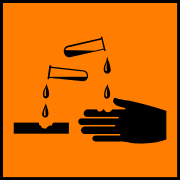|
Hydrolysis in this context means the effect of water on the ions of the salt. |
|
Salts of strong acids and bases
Salts are ionic compounds. When they dissolve in water they dissociate 100% producing free aqueous ions.
| NaCl → Na+(aq) + Cl-(aq) |
When both ions come from strong acid and bases, they have no interactions with the ions formed by the dissociation of water (hydrogen and hydroxide ions), however if the ions come from weak acids and bases, then they interact with the ions from water establishing equilibria.
Salts of a weak acid and a strong base
Salts of ethanoic acid produce free ethanoate ions in solution that can interact with the hydrogen ions from the water. The ethanoate ions set up an equilibrium producing ethanoic acid molecules by absorbing free hydrogen ions from the water. This effects the overall pH of the solution.
|
Example: Sodium ethanoate solution - CH3COOH(aq) Sodium ethanoate is 100% dissociated into ions:-
Sodium ions do not interact with the water ions. They remain free in the solution. However, the ethanoate ions do interact with the hydrogen ions
from the water equilibrium (H2O
We know that this last equilibrium lies to the side of the ethanoic acid (to the right), removing the hydrogen ions from the solution. As [H+] decreases, the pH rises. Hence a solution of sodium ethanoate has a pH greater than 7. We say that sodium ethanoate is basic by hydrolysis. |
Salts of a strong acid with a weak base
Ammonium chloride is the classic example of a salt formed by a strong acid (hydrochloric acid ) and a weak base (ammonia). When it is dissolved in water the ammonium ions interact with the free hydroxide ions from water, creating ammonia and water molecules. The effect is removal of hydroxide ions, which must be compensated for by increasing the hydrogen ion content of the solution to keep Kw unchanged.
|
Example: Ammonium chloride solution, NH4Cl Ammonium chloride dissociates 100% into ions in solution
The ammonium ions interact with the hydroxide ions from the water removing them from the solution (equilibrium lies to the right)
This increases the concentration of hydrogen ions (as [H+] x [OH-] is constant) increasing the acidity of the solution (decrease pH) We say that a solution of ammonium chloride is acidic by hydrolysis. |
General rules
- When the negative ion is from a weak acid then the salt is basic by hydrolysis
- When the positive ion is from a weak base then the salt is acidic by hydrolysis
- If the salt is formed from a strong acid and strong base then it is neutral
- If the salt is formed from a weak acid and weak base then its hydrolysis is determined by the relative Ka and Kb values
Salts of weak acids and bases
Without knowing the specific Ka and Kb values of the weak acid and weak base, it is not possible to know the relative acidity, or basicity, of any salt.
Ammonium ethanoate is one common salt of a weak acid and a weak base. It is very soluble and forms a neutral solution as the pKa of ethanoic acid is almost identical to the pKb of ammonia.


